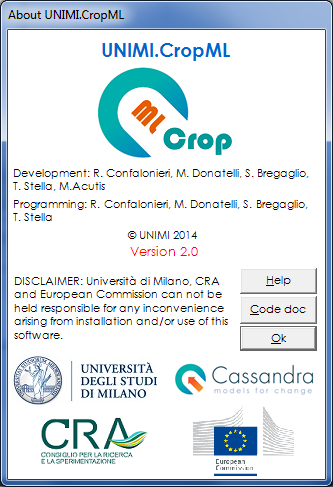District specific, in silico evaluation of rice ideotypes improved for resistance/tolerance traits to biotic and abiotic stressors under climate change scenarios.
 |
2015 - Climatic Change, 132, 661-675 |
 |
Paleari, L., Cappelli, G., Bregaglio, S., Acutis, M., Donatelli, M., Sacchi, G.A., Lupotto, E., Boschetti, M., Manfron, G., Confalonieri, R. |
Abstract:
Using crop models as supporting tools for analyzing the interaction between genotype and environment represents an opportunity to identify priorities within breeding programs. This study represents the first attempt to use simulation models to define rice ideotypes improved for their resistance to biotic stressors (i.e., diseases); moreover, it extends approaches for evaluating the impact of changes in traits for tolerance to abiotic constraints (temperature shocks inducing sterility). The analysis—targeting the improvement of 34 varieties in six Italian rice districts—was focused on the impact of blast disease, and of pre-flowering cold- and heat-induced spikelet sterility. In silico ideotypes were tested at 5-km spatial resolution under current conditions and climate change scenarios centered on 2020, 2050, and 2085, derived according to the projections of two general circulation models–Hadley and NCAR–for two IPCC emission scenarios–A1B and B1. The study was performed using a dedicated simulation platform, i.e., ISIde, explicitly developed for ideotyping studies. The ideotypes improved for blast resistance obtained clear yield increases for all the combinations GCM×emission scenario×time horizon, i.e., 12.1 % average yield increase under current climate, although slightly decreasing for time windows approaching the end of the century and with a marked spatial heterogeneity in responses across districts. Concerning abiotic stressors, increasing tolerance to cold-induced sterility would lead to a substantial yield increase (+9.8%) only for Indica-type varieties under current climate, whereas no increases are expected under future conditions and, in general, for Japonica-type varieties. Given the process-based logic behind the models used—supporting coherence of model responses under future scenarios—this study provides useful information for rice breeding programs to be realized in the medium-long term.
 |
Keywords: Blast, genotype × environment, spikelet sterility, Oryza sativa L., WARM. |
 |
DOI: 10.1007/s10584-015-1457-4 |
 |
AbioticDamage A software component for the impact of abiotic damages on crop productions |
 |
Blast Blast is a software component for the simulation of the development of rice blast disease |
 |
CropML CropML is a framework-independent component implementing a variety of approaches for crop growth |
 |
Diseases A software component to simulate plant-pathogen interactions |
- Comparison of three calibration methods for modeling rice phenology
- A simple pipeline for the assessment of legacy soil datasets: An example and test with soil organic carbon from a highly variable area.
- A high-resolution, integrated system for rice yield forecasting at district level.
- Downscaling rice yield simulation at sub-field scale using remotely sensed LAI data.
- Analysis and modelling of processes involved with salt tolerance and rice.
- Estimating crop nutritional status using smart apps to support nitrogen fertilization. A case study on paddy rice.
- Development of generic crop models for simulation of multi-species plant communities in mown grasslands.
- Quantifying uncertainty due to stochastic weather generators in climate change impact studies
- Predicting rice blast disease: machine learning versus process-based models
- Boundaries and perspectives from a multi-model study on rice grain quality in Northern Italy.






